

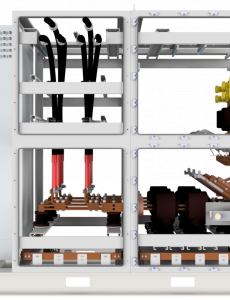
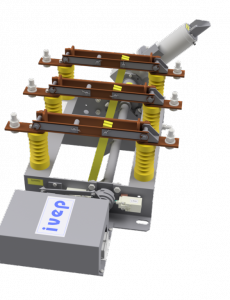
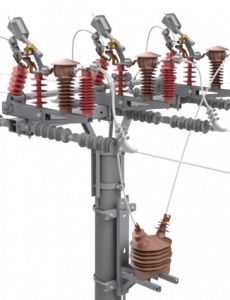

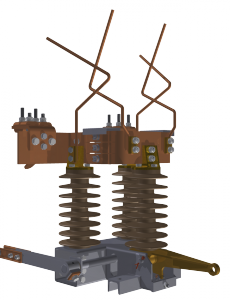
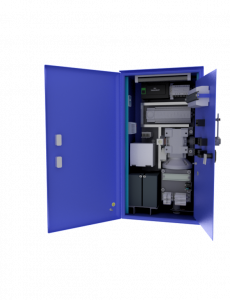
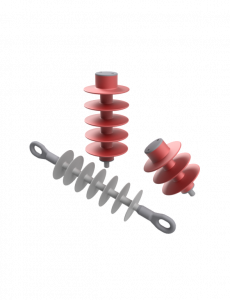

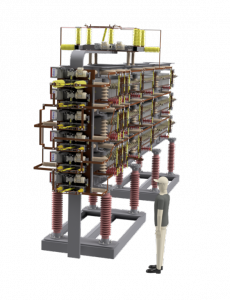


Really demanding customers prefer products by IVEP, a.s., because they are made based on more than fifty years of experience, gained worldwide. You will enjoy our work!
IVEP is using quality control system ISO 9001:2015, Environmental Management System ISO 14001:2015 and occupational health and safety system ISO 45001:2018.
Every year we introduce an entirely new product. We are proud of the speed with which we create new things.
You will always get exactly what you want from us. All products are tailored, according to who matters the most: you.
Energy systems with the highest quality for individual customer requirements as well as extreme conditions. We show the energy the way.
Our company values:
Our company vision:
To become the preferred top quality power systems supplier for power distribution grids, railways and industrial customers from around the world.
What we do?
High Voltage Generators
High voltage generators are a type of electric generator that produces electricity at a
high voltage, typically in the range of 100 kV to 1 MV. They are used in a variety of
applications, including power transmission, power distribution, and industrial
processes.
| Features High voltage generators are typically large and complex machines. They typically have three-phase output, and they can be either synchronous or asynchronous. Synchronous generators use a rotating magnetic field to generate electricity, while asynchronous generators use a rotating magnetic field to drive a rotating shaft. |
Advantages High voltage generators offer a number of advantages over lower-voltage generators. They are more efficient, they can transmit electricity over longer distances, and they are less susceptible to electrical noise. |
Medium Voltage Switches
Medium voltage switches are used to connect and disconnect circuits at medium
voltage, typically in the range of 1 kV to 35 kV. They are used in a variety of
applications, including power distribution, industrial processes, and
telecommunications.
| Features Medium voltage switches can be either air-insulated or gas-insulated. Air-insulated switches use air as an insulator, while gas-insulated switches use a gas such as sulfur hexafluoride (SF6) as an insulator. |
Advantages Medium voltage switches offer a number of advantages over lower-voltage switches. They are more reliable, they can withstand higher currents, and they are less likely to cause arcing. |
Medium Voltage Disconnectors
Medium voltage disconnectors are used to disconnect circuits at medium voltage,
typically in the range of 1 kV to 35 kV. They are used in a variety of applications,
including power distribution, industrial processes, and telecommunications.
Features
Medium voltage disconnectors can be either air-insulated or gas-insulated. Air-
insulated disconnectors use air as an insulator, while gas-insulated disconnectors
use a gas such as sulfur hexafluoride (SF6) as an insulator.
Advantages
Medium voltage disconnectors offer a number of advantages over lower-voltage
disconnectors. They are more reliable, they can withstand higher currents, and they
are less likely to cause arcing.
Medium Voltage Switchgear
Medium voltage switchgear is a combination of medium voltage switches,
disconnectors, and other equipment used to control and protect electrical circuits at
medium voltage. It is used in a variety of applications, including power distribution,
industrial processes, and telecommunications.
| Features Medium voltage switchgear can be either indoor or outdoor. Indoor switchgear is typically used in enclosed spaces, while outdoor switchgear is typically used in outdoor environments. |
Advantages Medium voltage switchgear offers a number of advantages over individual medium voltage switches and disconnectors. It is more compact, it is easier to install, and it is more reliable. |
Medium Voltage Earthing Switches
Medium voltage earthing switches are used to connect and disconnect a circuit to
earth at medium voltage. They are used in a variety of applications, including power
distribution, industrial processes, and telecommunications.
| Features Medium voltage earthing switches can be either air-insulated or gas-insulated. Air- insulated earthing switches use air as an insulator, while gas-insulated earthing switches use a gas such as sulfur hexafluoride (SF6) as an insulator. |
Advantages Medium voltage earthing switches offer a number of advantages over lower-voltage earthing switches. They are more reliable, they can withstand higher currents, and they are less likely to cause arcing. |
Load Break Switches
Load break switches are used to connect and disconnect circuits under load at
medium voltage. They are used in a variety of applications, including power
distribution, industrial processes, and telecommunications.
| Features Load break switches can be either air-insulated or gas-insulated. Air-insulated load break switches use air as an insulator, while gas-insulated load break switches use a gas such as sulfur hexafluoride (SF6) as an insulator. |
Advantages Load break switches offer a number of advantages over air-break switches and circuit breakers. They are more compact, they are easier to install, and they are more reliable. |
Conclusion
High voltage generators, medium voltage switches, disconnectors, switchgear,
earthing switches, and load break switches are all important electrical devices used
in a variety of applications. They offer a number of advantages over lower-voltage
devices, including efficiency, reliability, and ability to withstand higher currents.
Electric Drive for Operation of Switches
Electric drives are used to operate switches in a variety of applications, including
power distribution, industrial processes, and telecommunications. They offer a
number of advantages over mechanical drives, including:
Features
Electric drives for switch operation typically consist of the following components:
- A motor: The motor provides the power to operate the switch.
- A controller: The controller converts the electricity from the grid into a form that
can be used by the motor.
- A drive train: The drive train transfers the power from the motor to the switch.
Advantages
The advantages of electric drives for switch operation include:
- Improved reliability: Electric drives are less likely to fail than mechanical
drives, as they are not subject to wear and tear. This is because electric drives
do not have moving parts that can wear out or become damaged.
- Increased efficiency: Electric drives are more efficient than mechanical drives,as
they can use the power of the electricity grid to operate the switches. Thisis because
mechanical drives waste energy as heat.
- Improved safety: Electric drives can be used to operate switches from adistance,
which can improve safety for operators. This is because operatorsdo not need to be in
close proximity to the switches when they are beingoperated.
Smart Grid Systems
Smart grid systems are electrical grids that use digital technology to improve
efficiency, reliability, and security. They use a variety of technologies, including:
The advantages of smart grid systems include:
Conclusion
Electric drives and smart grid systems are both important technologies that are used
to improve the efficiency, reliability, and security of electrical grids. They offer a
number of advantages over traditional technologies, and they are likely to become
increasingly important in the future.